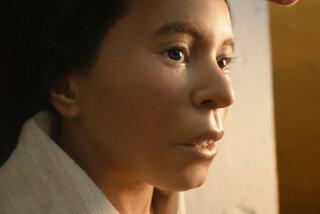Servant Girl Is a Cinderella in Stone : Archeology: Beautifully detailed Egyptian statue is the latest surprise from a cemetery that has produced many since its discovery last August.
- Share via
GIZA PLATEAU, Egypt — She works forever at the grindstone, but is garbed for grander stuff: red lipstick, black mascara, necklaces and a braided wig with ribbons in it.
The ancient Cinderella in stone has turned many heads since making her debut in February after more than 4,000 years in a tomb near the Giza pyramids.
Egyptian excavators found the statue of a servant girl in a cemetery for overseers and workmen from the days of the early Pharaohs. A team of experts restored it.
The limestone carving is a foot long and eight inches high, tinted with dyes of red, yellow and black, a rare survivor in the genre Egyptologists call “maid over millstone.”
It depicts a maidservant hard at work over a stone slab, her body bent forward, fingers wrapped around a roller and toes curled beneath her shapely form.
She wears a tight white skirt from waist to knees, but nothing above the waist. For hair, the anonymous ancient sculptor carved a fancy plaited wig decorated with a braided ribbon tied in a bow at the back.
She wears two necklaces and a bracelet. The delicate face, with a broad nose and tight lips, still bears traces of brushed-on color: Her eyes are rimmed with black eye shadow, her lips painted red with lipstick.
Whether she is rolling dough or grinding grain is the subject of debate, but there is no controversy about her charm and detail.
“She’s really lovely, a work of art,” said Zahi Hawass, antiquities director of the pyramids area and chief of the cemetery excavation.
The statue, not yet on regular display, is far superior to a famous one of a female servant crushing grain that is a tourist favorite at the Egyptian Museum in Cairo. That maidservant has no jewelry and only a simple wig.
Statues depicting servants at their chores were placed in a master’s tomb to make sure his soul would be served through eternity. Unlike Pharaohs and royalty, whose likenesses were carved to show regal majesty, common people could be portrayed with charm and endearing touches.
Servants were depicted carrying the master’s sandals, straining beer, making pots or roasting a goose on a brazier. The practice died out in Egypt’s later periods, replaced by paintings of working servants on tomb walls.
Hawass said the girl’s statue was the latest surprise from a cemetery that had produced many since its discovery last August. She and two other figures were found in a niche in the mud-brick tomb of an overseer, Kehy Neseb, and his wife, Heb-ny-Khawyess.
Salt has badly eroded the overseer’s statue, but that of his wife is in good condition. The figure depicts the lady of the house, obviously a woman of means, sitting on a chair.
As to the question of what the servant girl is doing at the stone, Hawass believes she is rolling dough to feed her master and mistress in the afterlife.
Amal Samuel, chief inspector for the pyramids area, disagrees.
“I think she’s crushing grain, because there’s part of a small sack at the back of the grindstone,” said Samuel, who was at the excavation site when the statue was found.
The cemetery contains the remains of overseers, workmen and their families from as early as the Fourth Dynasty, 4,600 years ago. Hawass dates the three statues to the Fifth Dynasty, which lasted 142 years and ended in 2323 BC.
More to Read
Sign up for Essential California
The most important California stories and recommendations in your inbox every morning.
You may occasionally receive promotional content from the Los Angeles Times.













